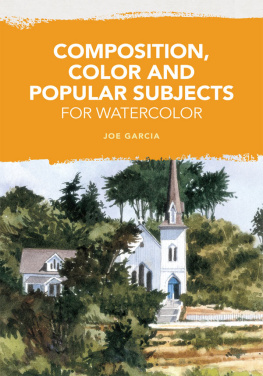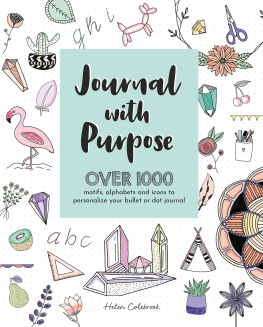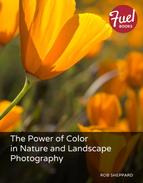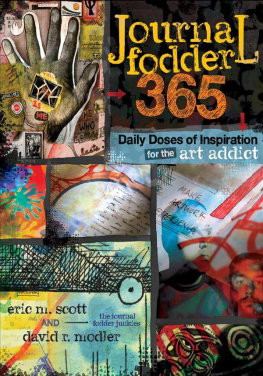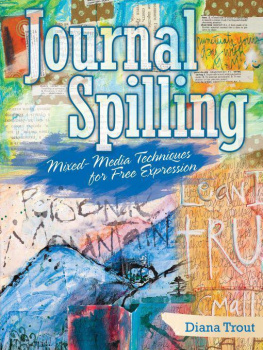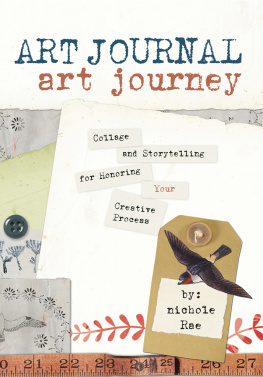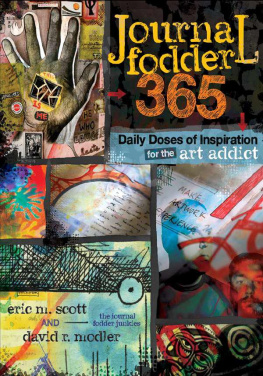Introduction

BIRDY
Why study composition and color? Art journaling has no rules, right?
Right.
I firmly believe theres value and beauty in every art journal page. Every single one.
But knowing (and then wielding) composition and color principles gives you a certain expressive freedom. The rules help you make conscious decisions about your art. They give you the freedom to express yourself in an effective way. And, for me, thats the goal of an art journalpersonal expression.
This book is not a comprehensive review of all design principles. Instead, we explore several principles of composition and color that apply to making art journal pages. Its a true exploration. We experiment with the principles, twist them, break them and have fun with them.
Each chapter of this book has a brief description of a principle. I give you examples and suggestions for when you might use that particular principle in your journaling. Then there are page challenges for you to put the principles into practice. Lastly, each chapter has one of my favorite art journaling techniques.
When you explore the rules in this book, make dozens of pages. No, make hundreds. The more you create, the more youll discover what works for you and what doesnt. Plus, youll become better at your craft. Theres no substitute for working consistently in your journal. Play, experiment, have fun and express. Give yourself permission to make pages you dont like. Not every page will be a masterpiece, nor should it be. Use the rules to help your soul spill out onto your journal. Remember, theyll make more paper. Ready, set, go!
Power Through Knowledge
When you understand design and color principles, you have power over them. You have power to arrange them, twist them and make them do what you want to convey your meaning and intent. You even have power to break them.
Chapter One
Tools and Materials
Journaling supplies are very personal. Each journal artist has her own preferences for paint, paper and pens. I have found it valuable to try many brands and types of tools. When I find something I love, I stick with it. Im happy to share with you what works for me. Your personal tools and materials list may have fewer items than this list or many more.
Pens
My main requirement for a pen is that it writes over dried ink and paint. The key here is dried. I cant tell you how many pens Ive ruined trying to write over wet paint (patience is not my strong suit). These are my go-to pens:

My go-to pens: water-based poster paint Sharpie (black and white), Japanese brush-tip pen, Marvey LePlumes dye-based marker, Fude 1.5mm roller ball, Faber-Castell pen.
Sharpie Water-Based Poster Paint Marker: This is my most-used pen. I buy the black and white in extra-fine point. I have nicknamed these shaky pens because you have to shake them a good long time to mix the ink (especially the white). You also need to burp the pen regularly (i.e., press the nib into the pen to keep the ink flowing).
Sharpie Extra Fine Point Marker: Extra Fine point is different than Ultra Fine point. The Extra Fine pens may be trickier to find. I have to buy them by the dozen at the office supply store. The nib is reinforced well, and they stand up to heavy use and rough surfaces.
Faber-Castell PITT Artist Pen: The India ink in these pens is lusciously dark. I like the medium nib, but many different sizes are available.
Ohto Fude Ball 1.5mm Roller Ball Pen: This is a Japanese pen that has a big 1.5mm roller ball. Ive had good luck writing with this, even over bumpy surfaces.
Dye-based marker: I often turn to dye-based markers (like Marvy LePlumes) to give a quick swipe of color to stamped images.
Brush pen: Im obsessed with buying Japanese calligraphy brush pens. They are fun to use and give a unique look to journaling.
Pencils
I use pencils to sketch, journal and scribble.
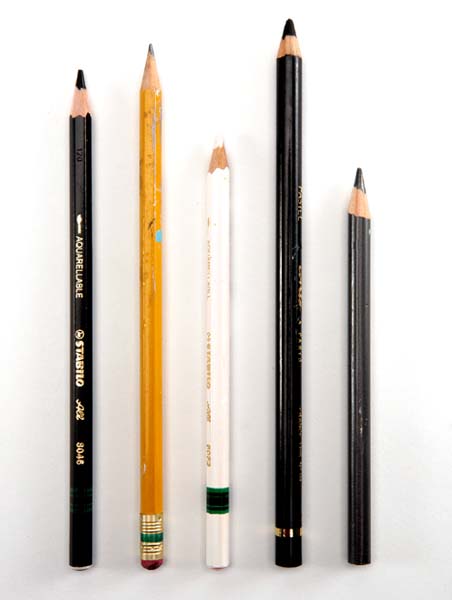
Pencils for sketching and journaling: Stabilo Marks All, B soft lead pencil, white Stabilo Marks All, charcoal pencil, Ebony pencil.
Stabilo Marks All: This pencil is made for writing on slick surfaces like glass and plastic, which is what makes it so great for writing over dried paint. The lead is soft and gives a dark, impressive line. I call this the magic pencil because of its properties. Its water-soluble, so you can run a wet brush over your lines to get a painted look. If you mess up, you can get most of it off your page with a baby wipe. Because it is so easily removed, I often seal my work with Workable Fixatif (addressed later in this chapter). I buy these pencils by the dozen in both black and white.
Ebony pencil: These are dark, soft pencils. Though not water-soluble, they are great for giving you a dark line when a regular pencil is too light.
Charcoal: Charcoal comes in many incarnations (pencil, stick, twig, different hardness levels). I have many different types, but I most often use a soft charcoal pencil (easy to grab out of my pencil box). Its delightfully smudgy. After I use charcoal in my journal, I seal it with Workable Fixatif.
Paint & Brushes
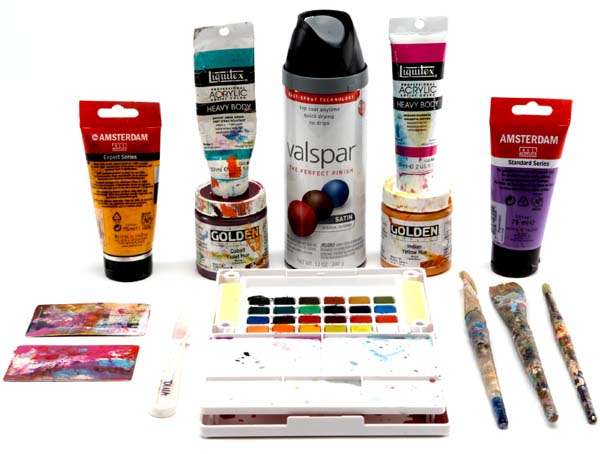
Painting tools and materials, from left to right: old gift cards for scraping paint, selection of acrylic paints and spray paints, paintbrushes, watercolor palette, palette knife.
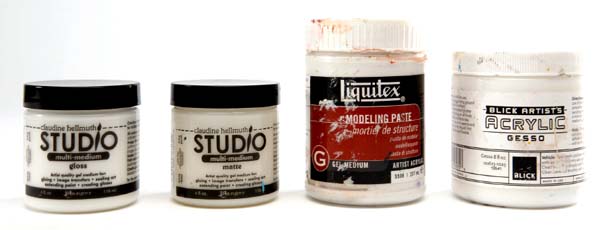
Gloss matte medium, matte gel medium, modeling paste, gesso.
Gesso: Gesso is like underwear for acrylic paint. You can get by without it, but something isnt right. Most of my pages start with a thin layer of gesso. The gesso coat gives acrylic paint something to hold onto. We call this tooth. Gesso helps me use less acrylic paint because the paint doesnt soak into the paper. Try putting paint on a piece of paper with gesso and a piece without gesso. You will see that the paint behaves differently on the gesso than it does on the plain paper. Many techniques I do are gesso-dependent. They just dont work if the gesso isnt there. Some gessoes are grittier than others. Try various brands and see what you like best. I admit to liking inexpensive gesso. Its great for journaling. Id rather spend money on acrylic paint than on gesso.
Acrylic paint:


